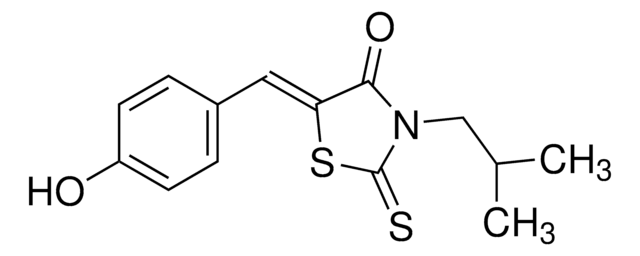SML3824
DRB18

≥98% (HPLC)
Synonym(s):
5,5′-(((4-Chloro-1,2-phenylene)bis(azanediyl))bis(methylene))bis(2-methylphenol), DRB 18, DRB-18
Sign Into View Organizational & Contract Pricing
All Photos(1)
About This Item
Empirical Formula (Hill Notation):
C22H23ClN2O2
CAS Number:
Molecular Weight:
382.88
MDL number:
UNSPSC Code:
12352200
Recommended Products
Quality Level
Assay
≥98% (HPLC)
form
powder
color
white to beige
solubility
DMSO: 2 mg/mL, clear
storage temp.
-10 to -25°C
SMILES string
ClC1=CC=C(C(NCC2=CC=C(C)C(O)=C2)=C1)NCC3=CC=C(C)C(O)=C3
Biochem/physiol Actions
Class I glucose transporters (GLUT1-4) inhibitor with greater anti-cancer efficacy than WZB117 (WZB-117) in cultures and in vivo.
DRB18 is a class I glucose transporters (GLUT1-4) inhibitor (glucose uptake IC50 = 2.6/8.8/4.5/0.9 µM using HEK293 GLUT1/2/3/4 transfectants) that exhibits greater anti-cancer efficacy than WZB117 (WZB-117) in cultures (IC50 <10 µM in 51 of 60 cancer cultures tested vs. only 17 from the same 60 cultures when using WZB117) and suppresses A549 xenografts-derived tumor growth in mice in vivo (44% reduction with 10 mg/kg i.p. 3x per wk for 5 wks) by altering the abundance of metabolites in glucose-related pathways.
DRB18 is a class I glucose transporters (GLUT1-4) inhibitor (glucose uptake IC50 = 2.6/8.8/4.5/0.9 µM using HEK293 GLUT1/2/3/4 transfectants) that exhibits greater anti-cancer efficacy than WZB117 (WZB-117) in cultures (IC50 <10 µM in 51 of 60 cancer cultures tested vs. only 17 from the same 60 cultures when using WZB117) and suppresses A549 xenografts-derived tumor growth in mice in vivo (44% reduction with 10 mg/kg i.p. 3x per wk for 5 wks) by altering the abundance of metabolites in glucose-related pathways.
Storage Class Code
11 - Combustible Solids
WGK
WGK 3
Flash Point(F)
Not applicable
Flash Point(C)
Not applicable
Certificates of Analysis (COA)
Search for Certificates of Analysis (COA) by entering the products Lot/Batch Number. Lot and Batch Numbers can be found on a product’s label following the words ‘Lot’ or ‘Batch’.
Already Own This Product?
Find documentation for the products that you have recently purchased in the Document Library.
Amanda Westergren Jakobsson et al.
Cancers, 14(13) (2022-07-10)
Neuroblastoma, the most common solid tumor in children, is characterized by amplification of the MYCN proto-oncogene, a high-risk aggressive clinical marker associated with treatment failure. MYCN plays an important role in cell growth, proliferation, metabolism, and chemoresistance. Here, we show
Pratik Shriwas et al.
Cancer & metabolism, 9(1), 14-14 (2021-03-28)
Cancer cells drastically increase the uptake of glucose and glucose metabolism by overexpressing class I glucose transporters (GLUT1-4) to meet their energy and biomass synthesis needs and are very sensitive and vulnerable to glucose deprivation. Although targeting glucose uptake via
Qingzhu Shi et al.
Cancer cell, 40(10), 1207-1222 (2022-09-10)
How glucose metabolism remodels pro-tumor functions of tumor-associated macrophages (TAMs) needs further investigation. Here we show that M2-like TAMs bear the highest individual capacity to take up intratumoral glucose. Their increased glucose uptake fuels hexosamine biosynthetic pathway-dependent O-GlcNAcylation to promote
Our team of scientists has experience in all areas of research including Life Science, Material Science, Chemical Synthesis, Chromatography, Analytical and many others.
Contact Technical Service






